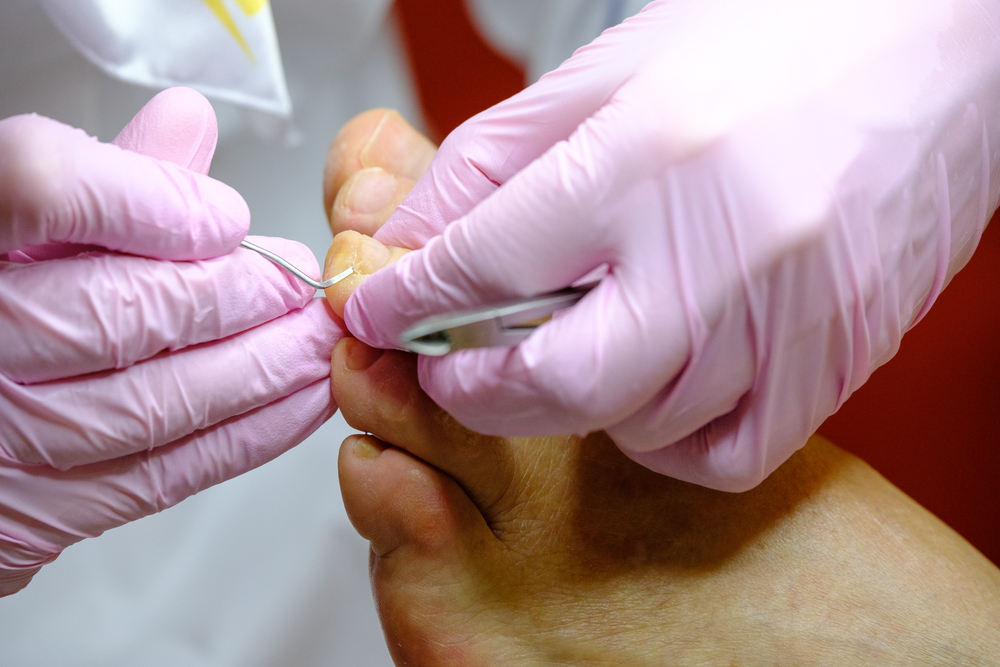An ingrown toenail is a common condition that can cause pain and discomfort or, in some cases, lead to an infection. Fortunately, it is easily treated with the help of a surgically trained podiatrist, a healthcare professional specialising in disorders of the foot.
Let’s take a closer look at this type of foot condition and find out how you can gain relief with the treatment options available.
What are ingrown toenails?
Ingrown toenails occur when the corner or edge of your toenail grows into the skin next to it, digging in and causing discomfort. You are at higher risk of an infected ingrown toenail if you live with diabetes or another condition that affects blood circulation.
What causes ingrown toenails?
There are lots of different causes of ingrown toenails. Risk factors for ingrown toenails include:
- Cutting toenails at an angle, which encourages the nail to grow into the skin
- Cutting toenails too short
- Having irregular or curved toenails
- Shoes or socks that put pressure on your toenails
- Shoes that are too narrow, tight or flat for your feet
- A toenail injury, such as stubbing your toe or dropping something heavy on your feet
- Poor posture
- Poor foot hygiene, such as not keeping your feet dry or clean
- Having sweaty feet, which means the nail and skin become soft
- Having diabetes or another condition, which means you have poor circulation
- Having thick toenails
- Practising activities that put pressure on the toenails, such as ballet or football
- A genetic predisposition to ingrown toenails
Symptoms of an ingrown toenail
In the early stages of an ingrown toenail, you may notice:
- The skin next to your ingrown toenail becoming swollen, tender or hard
- Pain when you put pressure on the affected toe
- Fluid around the toe
If you don’t seek treatment for your ingrown toenail, it may become infected with symptoms such as:
- Pain around the toe and toenail
- Swollen, red skin
- Bleeding
- Pus
- Excess skin around the toe
Possible complications of ingrown toenails
If your ingrown toenail isn’t treated, it may become infected. In turn, this can lead to the development of an infection, foot ulcers, sores or impaired blood flow to the area. Ingrown toenails can also become a severe problem if left untreated since the tissue around the ingrown toenail could decay or die.
If you have diabetes, you are more likely to suffer from ingrown toenail-related infections due to the lack of nerve sensitivity and blood flow in your feet. You should always seek professional advice for ingrown toenails if you are diabetic.
Treatments for ingrown toenails
Following a thorough assessment, the podiatrist will present the options for addressing the present pain, pathology and future management. If your ingrown toenail isn’t infected, your podiatrist may advise you to simply treat it at home.
You can do this by:
- Soaking your feet in warm water for 20 minutes three times a day (but you should take care to keep your feet dry when you are not soaking them)
- Pushing the skin gently away from your toenail with cotton soaked in olive oil
- Using over-the-counter medication to treat any pain
- Using a topical antibiotic or steroid cream to prevent infection
If you have an ingrown toenail that becomes swollen and infected, or if ingrown toenails are a recurring problem for you, the surgically-trained podiatrists at Podiatry First can perform a simple but permanent procedure that removes the offending portion of the nail and prevents it from growing back.
The procedure is carried out in less than 30 minutes and is performed using a local anaesthetic. It does not involve any cutting of skin or stitches, and recovery time is very short. In most cases, normal activity can be resumed the next day.
Providing ingrown toenail treatment Sydney-wide
For ingrown toenail treatment in Sydney, come and see us at Podiatry First. Our strength is focusing on you as a patient and accommodating your unique needs, whether that’s ingrown toenail treatment or any of the other services we offer, including:
- Laser fungal nail treatment
- Bunion treatment
- Biomechanical assessment
- Shockwave therapy
- Piriformis syndrome treatment
- Hip bursitis treatment
- Osteoarthritis knee treatment
Our goal is to help restore your feet to their full function and health so you can simply get on with your life, free of discomfort and pain.
Put your feet in good hands by coming to see our professional team in a venue that suits you. We offer ingrown toenail treatment Sydney-wide with locations in Sydney CBD, Bondi Junction and Miranda.
This means that wherever you are, you can consider us your local ingrown toenail treatment in Sydney!
Book a consultation today as your first step towards healthy, comfortable feet and a more active life!




